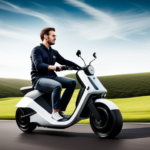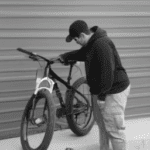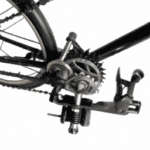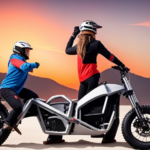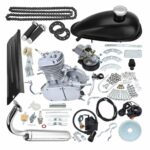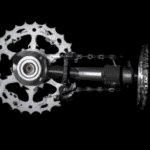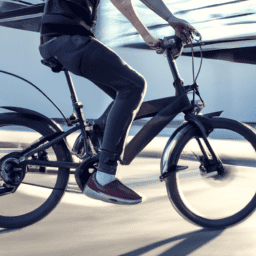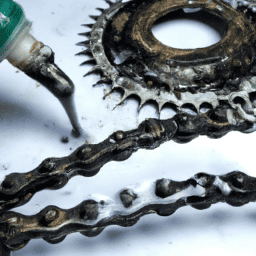Are you exhausted from pedaling your bike and yearning for some serious speed?
Well, hold on tight because I’m about to show you how to transform your ordinary bicycle into a high-powered, motorized machine!
In this step-by-step guide, I’ll walk you through the process of putting a lawnmower engine on your bicycle, giving you the exhilarating experience of a motorcycle with the convenience of a bicycle.
So buckle up and get ready to take your two-wheeled adventures to a whole new level!
Key Takeaways
- Connecting the fuel tank and fuel lines
- Installing an exhaust system
- Checking and adjusting the engine’s alignment
- Testing and fine-tuning the engine’s performance
Gather the Necessary Tools and Materials
Before attempting to put a lawnmower engine on a bicycle, you’ll need to gather the necessary tools and materials. Choosing the right engine is crucial for compatibility and efficiency. Look for a lightweight yet powerful engine that can drive the bicycle. Safety precautions should also be considered, such as a reliable kill switch and throttle control for speed adjustment. Additionally, ensure the engine comes with all necessary mounting brackets and hardware. Once you have gathered everything, you can proceed to the next step of choosing the right lawnmower engine for your bicycle modification.
Choose the Right Lawnmower Engine
To ensure proper functionality, it’s crucial to select the appropriate lawnmower motor for your bike. Choosing the right engine involves key considerations to ensure a successful conversion. Here are three factors to consider when selecting a lawnmower engine:
-
Power Output: Determine the power requirements based on the weight of your bike and the terrain you’ll be riding on. A higher horsepower engine may be needed for hilly terrains or heavier bikes.
-
Compatibility: Check the mounting dimensions and shaft size of the engine to ensure it fits your bike’s frame. Consider the weight and size of the engine to maintain a balanced and stable ride.
-
Fuel Type: Decide between a gas-powered or electric engine based on your preference and convenience. Gas engines offer more power, while electric engines are quieter and require less maintenance.
Now that you understand the key considerations, let’s move on to the next step: removing the bicycle’s rear wheel.
Remove the Bicycle’s Rear Wheel
First, make sure you have the necessary tools for removing your bike’s rear wheel. You will need a wrench, preferably an adjustable one, to loosen the nuts or quick-release skewer that holds the wheel in place.
Once you have the tools ready, start by flipping the bike over or placing it in a bike repair stand for stability. Locate the axle nuts or quick-release lever on either side of the rear wheel and loosen them using the wrench.
Once the nuts or lever are loose, you can slide the wheel out of the dropouts. Be careful not to damage any cables or gears in the process.
Now that the rear wheel is removed, we can move on to preparing the frame for the engine.
Prepare the Frame for the Engine
Once the rear wheel has been removed, it’s time to get the frame ready for the installation of the motor. To ensure the frame can handle the added weight and power of the lawnmower engine, frame reinforcement is crucial. This involves strengthening the frame by adding additional support bars or welding reinforcements at key stress points. By reinforcing the frame, you can prevent any potential damage or structural issues when the engine is attached.
Next, carefully consider the placement of the engine on the frame. Proper engine placement is essential for optimal performance and balance. A well-positioned engine ensures stability and maneuverability while riding the bicycle. Take into account factors such as weight distribution, center of gravity, and clearance for moving parts.
With the frame reinforced and the engine placement determined, we can now move on to the next step of the process: installing the engine mounting plate.
Install the Engine Mounting Plate
Now, you’ll need to attach the engine mounting plate to the reinforced frame. This step is crucial as it ensures that the engine is securely fastened to the bicycle.
To engage the audience, here are three important points to consider:
-
Common engine mounting problems: It’s important to be aware of potential issues such as misalignment or loose bolts that may arise during the installation process.
-
Troubleshooting tips: If you encounter any problems, try adjusting the mounting plate position or tightening the bolts. Additionally, double-check that the frame is properly reinforced to handle the engine’s weight.
-
Alternative engine mounting options, pros and cons: Depending on the specific bicycle and engine, there may be alternative mounting options available. It’s essential to weigh the advantages and disadvantages of each option to find the most suitable one for your setup.
With the engine mounting plate securely in place, you can now move on to the next section and attach the engine to the mounting plate.
Attach the Engine to the Mounting Plate
To attach the engine to the mounting plate, you’ll need to make sure it is securely fastened and aligned properly. Begin by placing the engine onto the mounting plate, ensuring that the bolt holes on the engine align with the corresponding holes on the plate. Insert the bolts through the holes and tighten them using a wrench, making sure they are snug but not overly tight. Once the engine is attached, double-check the alignment to ensure it is centered and straight.
Now, let’s discuss some troubleshooting common issues you may encounter during this process. Sometimes, the engine may vibrate excessively, which can be caused by loose bolts or misalignment. In such cases, tighten the bolts and adjust the engine’s position accordingly.
Additionally, here are a few tips for improving engine performance. Firstly, consider upgrading the air filter and exhaust system to enhance airflow and optimize power output. Secondly, regular maintenance, such as cleaning the carburetor and changing the oil, can greatly improve the engine’s efficiency and longevity.
With the engine securely attached to the mounting plate, we can now move on to connecting it to the bicycle’s rear wheel.
Connect the Engine to the Bicycle’s Rear Wheel
To connect the engine, make sure it is securely fastened and aligned properly before moving on to attaching it to the bicycle’s rear wheel. Here are the steps to connect the engine to the bicycle’s rear wheel:
-
Choose the appropriate mounting option for your bicycle. There are various kits available that provide different ways to attach the engine to your bike, such as using a rear rack or a frame-mounted bracket.
-
Ensure engine compatibility with your bicycle. Check the engine specifications and compare them with your bike’s rear wheel size and frame compatibility. Make sure the engine’s power output matches the requirements of your bike.
-
Position the engine in a way that allows for proper clearance and alignment with the rear wheel. This will ensure smooth power transfer and prevent any interference between the engine and the bicycle’s components.
-
Securely attach the engine to the mounting plate using bolts or other appropriate fasteners. Double-check that all connections are tight and secure.
By connecting the engine to the bicycle’s rear wheel, you’re one step closer to enjoying the benefits of a lawnmower-powered bicycle.
Next, we will explore how to install a throttle mechanism to control the engine’s speed.
Install a Throttle Mechanism
Installing a throttle mechanism allows for convenient control of the speed of your lawnmower-powered bike. To install a throttle cable, begin by attaching one end to the carburetor’s throttle lever.
Route the cable along the frame of the bicycle, making sure it doesn’t interfere with any moving parts. Secure it in place using zip ties or clamps.
Adjust the throttle sensitivity by tightening or loosening the cable as needed. Test the throttle by pulling it gently and observing the response of the engine. Fine-tune the sensitivity until you achieve the desired level of control.
With the throttle mechanism properly installed and adjusted, you are now ready to move on to the next step, which is connecting the fuel tank and fuel lines.
Connect the Fuel Tank and Fuel Lines
Once you have successfully installed the throttle mechanism, the next step is to connect the fuel tank and fuel lines. This is a crucial step in ensuring proper fuel delivery to the lawnmower engine. To begin, locate the fuel tank on the lawnmower engine and position it securely on the bicycle frame. Make sure it is easily accessible for refueling purposes. Next, attach the fuel lines to the fuel tank and route them along the frame, away from any moving parts. Use zip ties or clamps to secure the fuel lines in place and prevent any potential leaks. It is important to ensure that the fuel lines are not kinked or twisted, as this can disrupt fuel flow and lead to fuel system troubleshooting down the line. Connecting the fuel tank and fuel lines effectively is essential for fuel efficiency optimization. With this step complete, we can now move on to installing an exhaust system for the lawnmower engine.
| Pros | Cons |
|---|---|
| Improved power output | Increased weight |
| Enhanced acceleration | More complex installation |
| Sleek and stylish look | May require additional modifications |
| Better engine cooling | Louder noise output |
Moving on to the subsequent section about installing an exhaust system, we can further enhance the performance of the lawnmower engine.
Install an Exhaust System
The next step is to attach the exhaust system to optimize the lawnmower’s performance.
When designing the exhaust system for a lawnmower engine on a bicycle, there are a few important design considerations to keep in mind. First, the exhaust system should be positioned in a way that allows for proper airflow and prevents any interference with other bike components. Additionally, it should be designed to minimize noise and maximize the engine’s power output.
Troubleshooting tips for the exhaust system include checking for any leaks or loose connections that could affect performance. Regular maintenance, such as cleaning the exhaust system and inspecting it for any signs of wear or damage, is also crucial for optimal performance.
With the exhaust system properly installed, the next section will focus on checking and adjusting the engine’s alignment to ensure smooth operation.
Check and Adjust the Engine’s Alignment
To check and adjust your engine’s alignment, make sure it is properly aligned with the rest of your setup to ensure optimal performance. Here are some adjustment techniques and troubleshooting tips to help you get it right:
-
Ensure that the engine is mounted securely on the bicycle frame. Use appropriate brackets and fasteners to avoid any wobbling or movement during operation.
-
Check the alignment of the drive belt or chain. It should be running straight and not rubbing against any other parts.
-
Verify that the engine pulley and the bicycle wheel sprocket are aligned correctly. They should be parallel to each other for efficient power transfer.
-
Use a straightedge or a laser alignment tool to check the alignment visually. Make any necessary adjustments to achieve perfect alignment.
By following these adjustment techniques and troubleshooting tips, you can ensure that your engine is properly aligned and ready for the next step of testing and fine-tuning its performance.
Test and Fine-Tune the Engine’s Performance
Now it’s time to test and fine-tune the engine’s performance for optimal results. To ensure the smooth functioning of the lawnmower engine on the bicycle, it is crucial to test and optimize its performance. This involves conducting a series of tests and making necessary adjustments.
To begin, it is essential to check the engine’s compression by using a compression tester. This tool measures the pressure inside the engine’s cylinders, indicating the engine’s overall health. Additionally, monitoring the engine’s RPM (revolutions per minute) with a tachometer helps determine if it is running efficiently.
Furthermore, adjusting the carburetor is vital for achieving an ideal fuel-to-air mixture. A correctly adjusted carburetor ensures proper combustion and smooth engine operation. This can be done by referring to the engine’s manual for specific instructions on adjusting the carburetor’s idle speed and fuel mixture.
In conclusion, testing and fine-tuning the engine’s performance are crucial steps to optimize its functionality on the bicycle. By conducting compression tests, monitoring RPM, and adjusting the carburetor, we can ensure the engine operates optimally. Moving forward, it is essential to address safety measures to ensure a secure riding experience.
Ensure Proper Safety Measures
Once all the necessary adjustments are made, it’s important to ensure proper safety measures are in place. Ensuring safety is of utmost importance when dealing with a lawnmower engine on a bicycle.
Safety precautions must be followed to prevent accidents and injuries. To ensure a safe riding experience, there are several safety tips and guidelines to consider.
Firstly, always wear appropriate safety gear such as a helmet, goggles, and sturdy shoes.
Secondly, make sure the engine is securely mounted to the bicycle frame to avoid any detachments while riding.
Additionally, it is crucial to install a kill switch or an emergency stop button for immediate engine shutdown in case of any mishaps.
Finally, regularly inspect the engine and its components to identify any potential safety hazards.
By adhering to these safety measures, you can enjoy a safe and smooth ride.
Moving forward, it is essential to maintain and service the engine regularly to optimize its performance and longevity.
Maintain and Service the Engine Regularly
Make sure you regularly maintain and service your lawnmower engine on your bicycle to keep it running smoothly. Proper maintenance is crucial for the longevity and performance of the engine.
Here are some maintenance tips to follow. First, check the oil level regularly and change it as recommended by the manufacturer. Inspect the air filter and clean or replace it if necessary to ensure proper airflow. Additionally, clean the spark plug regularly and replace it if it’s worn or damaged.
Troubleshooting common issues is also important. If the engine is hard to start, check the fuel filter and make sure it’s clean. If the engine is running rough, adjust the carburetor settings.
By performing regular maintenance and troubleshooting, you can ensure that your lawnmower engine on your bicycle operates at its best. This will set you up to enjoy your newly motorized bicycle!
Enjoy Your Newly Motorized Bicycle!
Get ready to have a blast with your newly motorized bike! Transforming your bicycle into a motorized powerhouse opens up a whole new world of excitement and convenience. Here are some advantages of having a motorized bicycle:
-
Increased speed: With the added power of a lawnmower engine, you can effortlessly cruise at higher speeds, making your commute or leisure rides much quicker.
-
Uphill assistance: Tackling hilly terrains becomes a breeze as the engine provides the necessary boost to conquer any incline.
-
Extended range: The engine’s fuel efficiency allows you to travel longer distances without worrying about running out of gas.
To ensure a smooth ride, it’s essential to troubleshoot any engine issues that may arise. Here are some tips for troubleshooting:
-
Check the fuel system: Ensure the fuel tank is adequately filled, and the fuel lines are clear of any clogs or blockages.
-
Inspect the spark plug: A faulty spark plug can cause engine misfires. Clean or replace it if necessary.
-
Examine the air filter: A dirty air filter restricts airflow, leading to reduced engine performance. Clean or replace it regularly.
By following these tips, you’ll be able to fully enjoy the benefits of your motorized bicycle and troubleshoot any engine issues that may arise.
Happy riding!
Frequently Asked Questions
How often should the engine on a motorized bicycle be serviced?
The engine on a motorized bicycle should be serviced regularly to maintain its performance. The maintenance frequency depends on usage but generally, it is recommended to service the engine every 3-6 months. Regular oil changes, spark plug inspection, and cleaning the air filter are essential. Troubleshooting tips include checking for fuel leaks, ensuring proper fuel mixture, and inspecting the carburetor for any blockages.
What are some safety measures that should be taken when operating a motorized bicycle?
When operating a motorized bicycle, it is crucial to prioritize safety. Wearing proper safety gear such as a helmet, gloves, and protective clothing can greatly reduce the risk of motorized bicycle accidents.
How can the engine’s alignment be checked and adjusted?
To check the engine’s alignment, first, ensure the engine is securely mounted to the bicycle frame. Then, visually inspect the alignment of the engine with the bicycle’s chain and sprockets. Adjust the engine’s position as needed to ensure proper alignment.
What tools and materials are needed to install a lawnmower engine on a bicycle?
To install a lawnmower engine on a bicycle, you will need tools such as wrenches, screwdrivers, and pliers, as well as materials like mounting brackets, chains, and a throttle cable. Common challenges include ensuring proper alignment and integrating the engine with the bicycle’s frame. Cost considerations include purchasing the necessary tools and materials, as well as any modifications needed for the bicycle.
Can any type of lawnmower engine be used for this project, or are there specific types that work best?
For the lawnmower engine selection, it is important to consider factors such as power output, weight, and compatibility with the bicycle frame. While there are alternative engine options, specific types like small, lightweight engines often work best for this project.
Conclusion
Well, that’s a wrap folks! After hours of hard work and a few cuts and bruises, my bicycle has been transformed into a magnificent motorized machine.
With the right tools and materials, a carefully chosen lawnmower engine, and some skillful engineering, I’ve successfully attached the engine to the bike frame.
Taking safety precautions and ensuring regular maintenance, I’m now ready to hit the road with my newly upgraded ride.
So hop on board, buckle up, and let’s embark on this thrilling journey into the past, where old meets new in the most exhilarating way possible!


